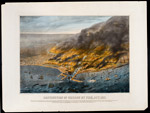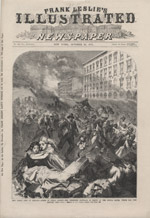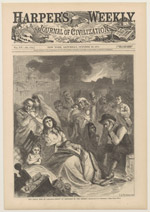Media Event
"All sit here and write whatever comes into your heads!"
A Chicago newspaper editor to his reporters, in John McGovern, Daniel Trentworthy: A Tale of the Great Fire of Chicago
The coverage of the fire in the media was the most important factor in how it was remembered, since this was by far the major means through which everyone, including Chicagoans, received most of their information about what had happened. Reporters, writers, illustrators, photographers, editors, and publishers decided for the waiting world which aspects of the fire should be discussed, where the emphases should go, and how issues should be framed. In so doing, they made as well as reported the appalling news from Chicago, especially in those instances where they seasoned their stories with a heavy helping of conjecture, exaggeration, and even fabrication. The process by which all this happened was complicated by the fact that the media, then as now, were influenced by existing conventions of reporting, the technologies they employed, their assumptions about their audience, and the need to sell their product.
The burning of Chicago was an irresistible story. The inherently spectacular nature of a great urban fire, and the fact that one of such epic scale had struck this particular city, immediately guaranteed wide and eager interest. More important, an unprecedented combination of recent developments--major advances in high-speed and mass-production printing, construction of a national transportation and international communications network (the transcontinental railroad and the transatlantic cable had been recently completed), an enormous readership clustering in cities, and a rising number of publishers and professional authors--made the fire arguably the country's first "instant" media event. While local residents learned of the disaster through the ancient technology of a tolling bell, the modern telegraph shared the news of the destruction of Chicago virtually as it unfolded, so that an enormous audience dispersed over a vast area probably had a more coherent sense of what was happening than those living through it at the time.
It was only a matter of days and weeks before there were numerous lithographic representations of the fire available, as well as thousands of stereographs. They competed for public attention with a few dozen rapidly assembled fire histories, from flimsy paperbacks to hefty bound volumes. These instant histories were closely related to the journalism of the fire since they were usually written by reporters, who supplemented their gripping narratives with illustrations taken from the weekly illustrated magazines. In addition to descriptions of the calamity, they featured sections on specific incidents of note, actions by officials, prospects for the future, "lessons" of the disaster, and great fires through the ages. Even the titles of some the histories could barely contain their excitement, as revealed by the fact that they were a paragraph long and spiked with exclamation points.
Perhaps because it was still a novelty, the speed with which events were reported became part of the story. As successive dispatches arrived faster than extra editions could be turned out, editors printed these updates--numbering in some cases into the teens--one right after another in a single issue, separated by datelines that noted the hour, so that readers far and wide could witness the fire's advance across Chicago in the columns of their local papers. When people and groups in other places then contributed relief supplies as the city was still burning, this became a major news story. Once Chicago newspapers were publishing again--most were back in business within a few days--local residents could then see reprints of the coverage that originally appeared in other cities. What the public everywhere was ultimately reading about was themselves as a community closely linked by what they read.
What did they find in the stories about the fire? The professionally produced "graphic accounts" in the newspapers, magazines, and instant histories included every manner of opinion and detail, but, as is the case with the personal narratives, what they said is in many respects less intriguing than how they said it. As a rule, the diction was far less restrained and the tone far more sensational than in the eyewitness accounts, as authors vied with each other for the paying public's attention. Partly because of the hasty and eclectic manner in which the source material was gathered and fashioned into narrative, the styles of reporting are mixed and uneven. We find the Chicago Times juxtaposing in one story a sober analysis of the city's credit rating with a description of how the "twin rioters of flame and wind, with their appetite sharpened instead of gorged by the blast among the meaner buildings of the West division and river side...fell in dire carnival upon the noble edifices of LaSalle Street." Authors asked their readers' indulgence, given the challenges their presented to any attempt to represent it. "It is a chapter of horrors that can only be written as it was, with a pen of fire," declared one fire history, "but our task it to clothe in words an approximate idea of its realities...."
Different forms of expression within single newspapers, magazines, or histories expressed different kinds of outlooks, from a sentimental view of the fire as a test of heart and soul that Chicago and the civilized world passed with flying colors, to a no-nonsense prescription of what rules and regulations must be implemented to avoid the same irresponsible oversights that allowed this catastrophe to occur. Certain aspects and incidents of the fire seemed to evoke and justify particular attitudes and beliefs. The stories of bravery, selflessness, quick-thinking, and enterprise indicated that the city's upright character had seen it through this crisis. But the talk of sloppy building and the tales of drunkenness and looting, of vigilantes stringing up would-be arsonists, of unspeakable atrocities against defenseless women in the places of refuge, and of General Sherman coming to the rescue revealed a deep suspicion that there was a large unruly underclass that was always ready to raise its ugly head the moment the city's guard was down.
There is no question that the more positive view dominated the reporting and commentary, and, beyond that, the public memory of the fire. But the persistent doubts and fears expressed in the media were also an important part of the heritage of the whole experience, influencing subsequent discussions about the need for regulation and how different classes perceived each other. What was common to these very different outlooks was that they both served an audience seeking to comprehend this incomprehensible event and the elusive and contradictory nature of the urban culture they were all creating together.









